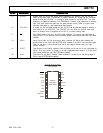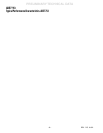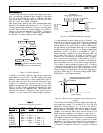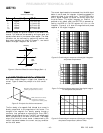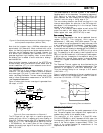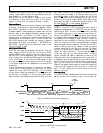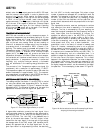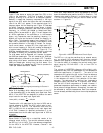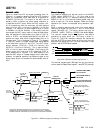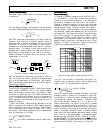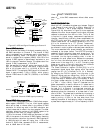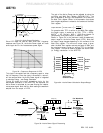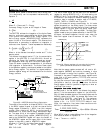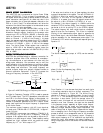
ADE7753
–15–
REV. PrC 01/02
PRELIMINARY TECHNICAL DATA
Antialias FilterAntialias Filter
Antialias FilterAntialias Filter
Antialias Filter
Figure 17 also shows an analog low pass filter (RC) on the
input to the modulator. This filter is present to prevent
aliasing. Aliasing is an artifact of all sampled systems.
Basically it means that frequency components in the input
signal to the ADC which are higher than half the sampling
rate of the ADC will appear in the sampled signal at a
frequency below half the sampling rate. Figure 19 illustrates
the effect. Frequency components (arrows shown in black)
above half the sampling frequency (also know as the Nyquist
frequency, i.e., 447kHz) get imaged or folded back down
below 447kHz (arrows shown in grey). This will happen with
all ADCs regardless of the architecture. In the example
shown, only frequencies near the sampling frequency, i.e.,
894kHz, will move into the band of interest for metering, i.e,
40Hz - 2kHz. This allows the usage of very simple LPF (Low
Pass Filter) to attenuate high frequency (near 900kHz) noise
and prevents distortion in the band of interest. For conven-
tional current sensor, a simple RC filter (single pole LPF)
with a corner frequency of 10kHz will produce an attenuation
of approximately 40dBs at 894kHz—see Figure 18. The
20dB per decade attenuation is usually sufficient to eliminate
the effects of aliasing for conventional current sensor.
For di/dt sensor such as Rogowski coil, however, the sensor
has 20dB per decade gain. This will neutralize the -20dB per
decade attenuation produced by the simple LPF. Therefore,
when using a di/dt sensor, care should be taken to offset the
20dB per decade gain coming from the di/dt sensor. One
simple approach is to cascade two RC filters to produce the
-40dB per decade attenuation needed.
Fre
q
uenc
y
(
Hz
)
Aliasing Effects
0
447kHz
894kHz
2kHz
image
frequencies
Sampling Frequency
Figure 19 —ADC and signal processing in Channel 1
ADC transfer functionADC transfer function
ADC transfer functionADC transfer function
ADC transfer function
Below is an expression which relates the output of the LPF
in the sigma-delta ADC to the analog input signal level. Both
ADCs in the ADE7753 are designed to produce the same
output code for the same input signal level.
144,2620492.3)( ××=
out
in
V
V
ADCCode
Therefore with a full scale signal on the input of 0.5V and an
internal reference of 2.42V, the ADC output code is nomi-
nally 165,151 or 2851Fh. The maximum code from the
ADC is ±262,144, this is equivalent to an input signal level
of ±0.794V. However for specified performance it is not
recommended that the full-scale input signal level of 0.5V be
exceeded.
ADE7753 Reference circuitADE7753 Reference circuit
ADE7753 Reference circuitADE7753 Reference circuit
ADE7753 Reference circuit
Shown below in Figure 20 is a simplified version of the
reference output circuitry. The nominal reference voltage at
the REF
IN/OUT
pin is 2.42V. This is the reference voltage used
for the ADCs in the ADE7753. However, Channel 1 has
three input range selections which are selected by dividing
down the reference value used for the ADC in Channel 1. The
reference value used for Channel 1 is divided down to ½ and
¼ of the nominal value by using an internal resistor divider
as shown in Figure 20.
PTAT
60µA
1.7kΩ
12.5kΩ
12.5kΩ
12.5kΩ
12.5kΩ
2.5V
2.42V
REF
IN/OUT
Reference input to ADC
Channel 1 (Range Select)
2.42V, 1.21V, 0.6V
Maximum
Load = 10µA
Output
Impedance
6kΩ
Figure 20 —ADE7753 Reference Circuit Ouput
The REF
IN/OUT
pin can be overdriven by an external source,
e.g., an external 2.5V reference. Note that the nominal
reference value supplied to the ADCs is now 2.5V not 2.42V.
This has the effect of increasing the nominal analog input
signal range by 2.5/2.42×100% = 3% or from 0.5V to
0.5165V.
The voltage of ADE7753 reference drifts slightly with
temperature—see ADE7753 Specifications for the temperature
coefficient specification (in ppm/°C) . The value of the
temperature drift varies from part to part. Since the reference
is used for the ADCs in both Channel 1 and 2, any x% drift
in the reference will result in 2x% deviation of the meter
accuracy. The reference drift resulting from temperature
changes is usually very small and it is typically much smaller
than the drift of other components on a meter. However, if
guaranteed temperature performance is needed, one needs to
use an external voltage reference. Alternatively, the meter can
be calibrated at multiple temperatures. Real time compensa-
tion can be easily achieved using the on the on-chip temperature
sensor.



